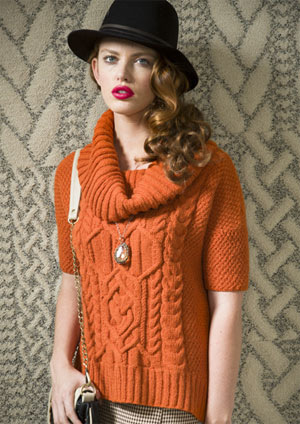The celebrated knitwear designer offers insight into her design process.
By Christina Behnke After seeing Norah Gaughan’s Pattern Stitch Development and Design Possibilities lecture at Vogue Knitting LIVE New York 2014—where she overviewed the birth of a stitch pattern from concept to swatch—we just had to get a further look into this visionary designer’s creative process. Gaughan spoke to Associate Editor Christina Behnke about inspiration, innovation, and how Wikipedia plays a role in naming her designs.
After seeing Norah Gaughan’s Pattern Stitch Development and Design Possibilities lecture at Vogue Knitting LIVE New York 2014—where she overviewed the birth of a stitch pattern from concept to swatch—we just had to get a further look into this visionary designer’s creative process. Gaughan spoke to Associate Editor Christina Behnke about inspiration, innovation, and how Wikipedia plays a role in naming her designs.
Your background in biology is well known, especially since so many of your designs are influenced by forms found in nature. How does living in New England influence your design aesthetic?
The cold weather is definitely an influence! It’s easy to design wool sweaters when you really need them. The New England aesthetic of practicality over looks tugs on me as well. I work very hard to balance pretty and useful.
What approach do you take towards incorporating fashion trends into your designs?
I like to look at what’s new and soak in the silhouettes and techniques popular now. My favorite work [comes from] meshing something else I am thinking about with fashion. So, if I am on a roll with say, cable patterns, how can I make it look modern and fit right with today’s underpinnings—say, super skinny pants? I am always changing my idea of what I want to wear, too. It all goes together.
Throughout your career, you’ve seen knitters’ preferences change: many knitters work in the round to avoid seaming, while top-down knits have become popular. (2013’s Norah Gaughan Vol. 13 was your first collection of top-down knits.) How have these changing trends affected you as a designer?
These trends give me something new to think about, something new to figure out. I love those personal victories when I do something I haven’t done before or figure out how to do something in a new way.
How do you go about naming your designs?
Naming starts with a theme, then progresses with web research, often involving Wikipedia (which is why I donate to them every year.) The thesaurus is my friend as well. Sometimes I have to stretch the original idea a bit to get the quantity of good names required. For instance, for my latest Berroco booklet, Norah Gaughan Vol. 14, I started with the idea of triangles and wedges. All of the designs were influenced by this theme. For names, I started with the word “wedge,” found synonyms and then synonyms of synonyms. I try to keep the meaning relevant, but sometimes I stray.
You might be known primarily as a knitwear designer, but you started crocheting at a young age and recently designed a cowl for Crochet Red (Sixth&Spring Books). What are the benefits of knowing both crafts?
I wish everyone knew both crafts so I could mix them together more often. Crocheting is so great for free form expression, and in my opinion [it’s] more difficult to write up for others to follow. I use crochet a lot for edgings and for firm fabrics. Crochet is also great when you need to work up a present quickly. Knowing both crafts means you can work up the kind of fabric you want. You’re less limited.
